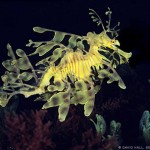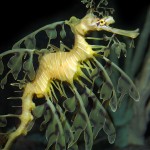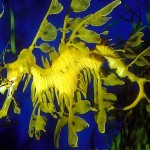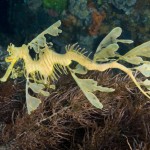Leafy Seadragon Facts
Scientific Classification of Leafy Seadragon: Phycodurus eques
Kingdom of Leafy Seadragon: Animalia
Phylum of Leafy Seadragon: Chordata
Class of Leafy Seadragon: Actinopterygii
Order of Leafy Seadragon: Syngnathiformes
Family of Leafy Seadragon: Syngnathidae
Genus of Leafy Seadragon: Phycodurus
Species of Leafy Seadragon: P.eques
Leafy Seadragon
These species belong to the originally to the Sygnathidae family. Their name resembles the leafy structures that are present profusely over their body. They are also referred to as the Glauerts seadragon. They are also regarded as the member of Phycodurus genus. One can spot these species in the coastal areas of the South Western parts of Australlia.
Pictures of Leafy Seadragon
We present some beautiful pictures of leafy seadragons:
Some Interesting Facts about Leafy Seadragon
Here is a glimpse of some of the interesting facts about these species:
- These species can also be called as leafies
- They are found in marine regions of Southern Australia.
- They have the ability to withstand the wild environment and adapt well with the art of pretending.
- These species do not contain any kind of belly. They usually eat frequently in order to prevent fasting.
- These species have no predators.
Distribution of Leakfy Seadragon
The Leafy Seadragon can be found in the Southern and Western coast of Australia.
Characteristics of Leafy Seadragon
- Size of Leafy Seadragon: The size of these species varies from 24 – 34 cm. As compared to other seahorses they are much larger in size.
- Fins of Leafy Seadragon: One can see leaf like fins present spread over their body. From the neck comes out the pectoral fins while there is an isolate dorsal fin situated on the back portion.
- Color of Leafy Seadragon: The color of these species varies from brown to yellowish green. One would see the color changes due to change in location or diet.
- Eyes of Leafy Seadragon: The eyes are situated on the upper portion of the protruding snout.
- Spines of Leafy Seadragon: Numerous spines are present on the body of these species which are mainly used for protection.
Behavior of Leafy Seadragon
- The movement of these species is very swift and they always disguise for survival.
- These species usually move easily among the aquatic plants.
- These species are not matched with other species. However, they endeavor to match with pipe fishes and other seahorses.
- By nature these species are solitary.
Food Habits of Leafy Seadragon
The Leafy Seadragon generally uses its long snout and small mouth to get hold of the victim. These generally like to have mysid shrimps, zooplanktons, panaied shrimps, larval fish, amphibians and sea lice in their diet.
Habitats of Leafy Seadragon
These species like to dwell on meadows, rocky reef, seagrass, seaweed and sand patches primarily in Australia.
Movement of Leafy Seadragon
These species actually move with the help of the pectoral, dorsal fins .The external skin is very fixed and is less mobile, and flexible. These species can stay in one place for long duration. These species are known to move very fast and sometimes even at a speed of 150 km per hour.
Predators of Leafy Seadragon
The main predators of the juvenile sea horses are giant crustaceans, fishes and anemones. The older ones do not really have any enemies.
Adaptations of Leafy Seadragon
We take a tour of the adaptive features of these species:
- These species use the protrusions for disguising themselves.
- The fins of these species are transparent and make them look like seaweeds when they move from one side to another.
- These seadragons can also bring a change in color of eggs to match with the environment. In addition to this, they comprise of some spines on their bodies used primarily to fortify themselves.
- They have eyes that move without bindings. However, this feature helps them to look at different directions simultaneously.
Mating Season of Leafy Seadragon
The mating season of these species ranges between August to March.
Reproduction of Leafy Seadragon
- These species become sexually matured at the age of 28 months.
- It is unique to note that the males bear the babies in the womb. While breeding the female counterparts generally gives 250 pink colored offspring. Then she keeps them on the tail of the male counterpart. The eggs are found clinging to the brood patches which has blood tissues.
- In each of the tissues, single egg is present that is provided with oxygen. These species produce two clutters of eggs out of which only 5 % exists. Just after few weeks, the color of the eggs gets purple or orange. The whole procedure takes 24 – 48 hours. After this, male counterparts start to produce the offspring.
Life Cycle of Leafy Seadragon
The juvenile ones are only 20 cms long. As soon as their born, they become free from the bindings. The younger ones feed on zooplanktons until they are grown enough to have mysid shrimps. The juvenile ones are very fragile and have a body color that is unique as well.
Petting of Leafy Seadragon
While petting leafy seadragon, one needs to be extremely careful in handling of the sea horses. These species are very fragile; therefore, it is difficult to retrieve and keep them away from their wild environment. One should make sure to maintain a proper water pressure and a good supply of food. Crustacean diet should make them happy. These species like to stay isolated hence it is better to keep them away from other species.
Life Span of Leafy Seadragon
The original life span is not yet known. However, these species are believed to live for about two years in their natural environment.
Conservation Status of Leafy Seadragon
According to the reports of IUCN they are listed in the category of near endangered.




